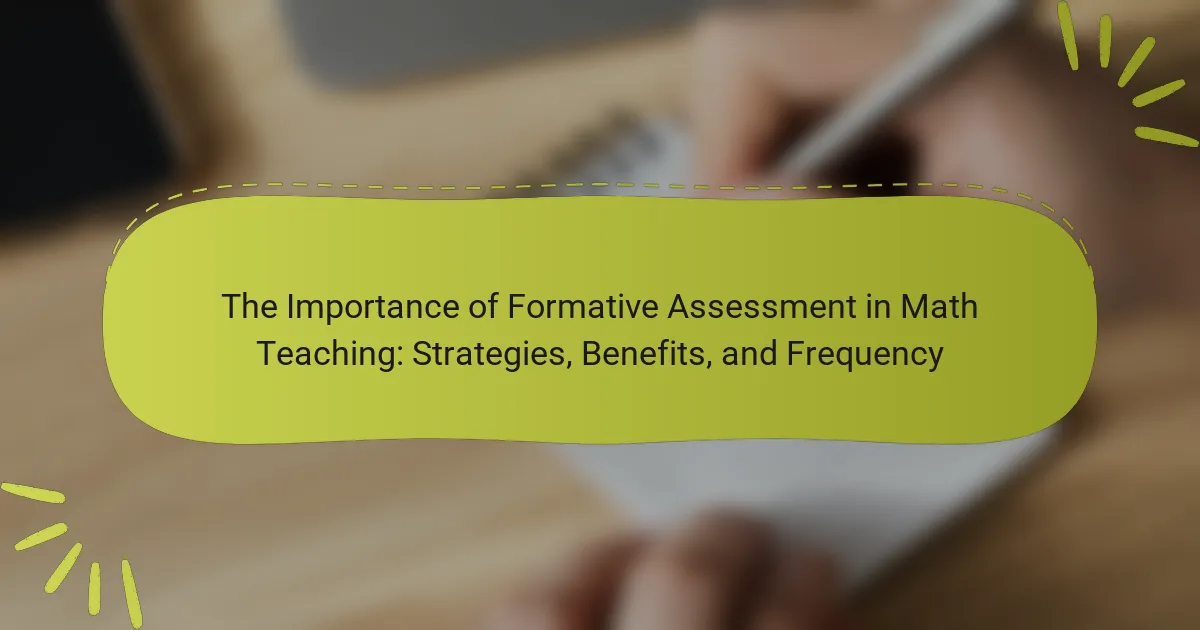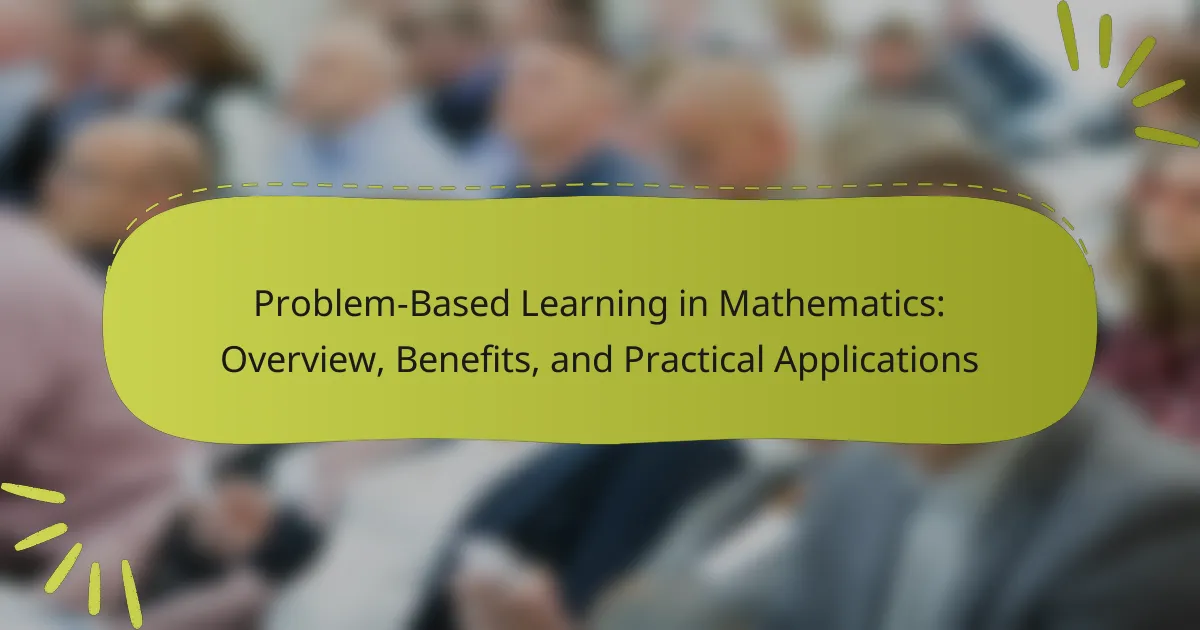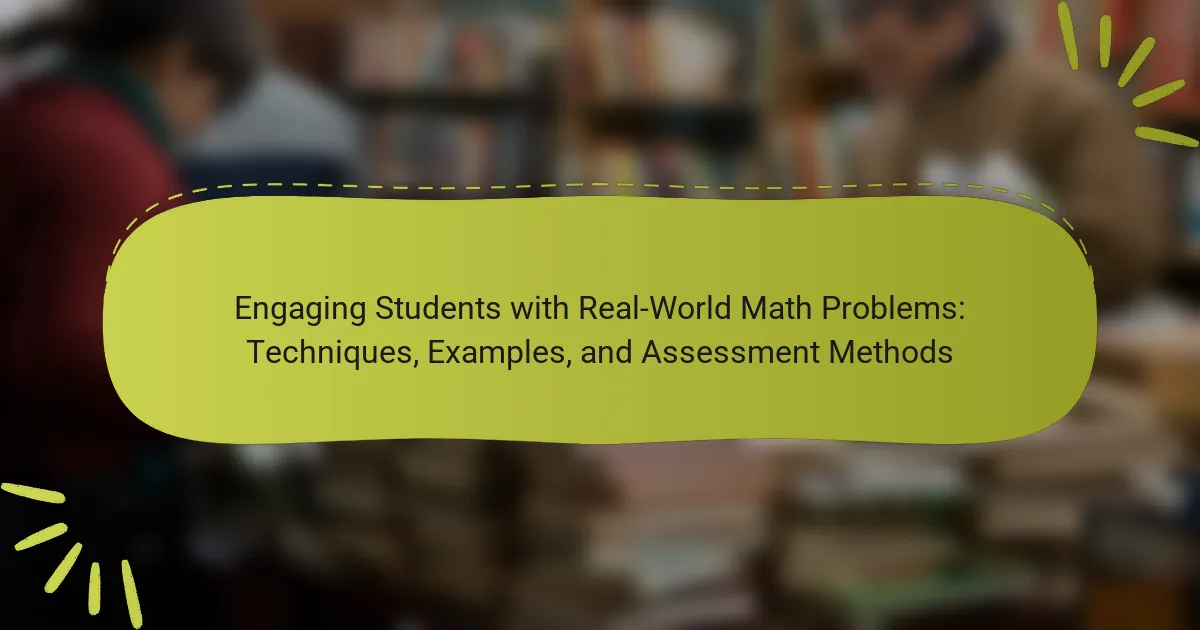The article focuses on the integration of technology in math education, highlighting various tools and techniques that enhance learning outcomes. Key tools include interactive software like GeoGebra, online platforms such as Khan Academy, and digital resources that facilitate visualization and problem-solving. The article outlines strategies for educators to effectively incorporate these technologies, including the use of smartboards, collaborative platforms, and data analytics for tracking student progress. Research indicates that technology integration leads to improved engagement and higher assessment scores among students, ultimately transforming traditional teaching methods.
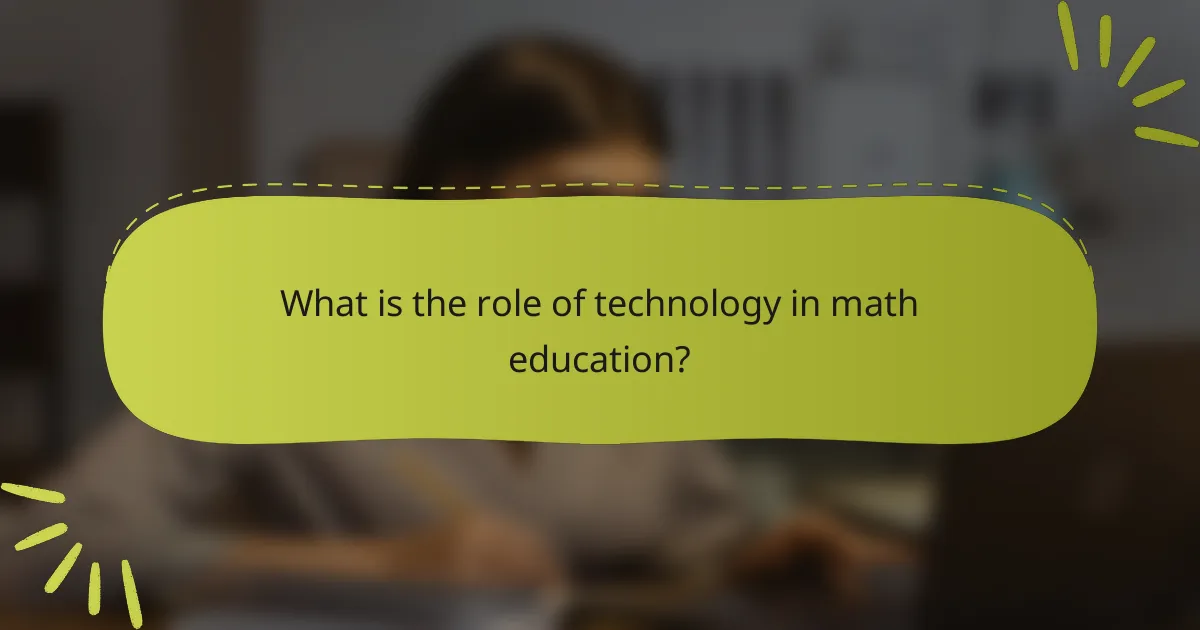
What is the role of technology in math education?
Technology plays a crucial role in math education by enhancing learning and engagement. It provides interactive tools that make complex concepts more accessible. For instance, software like GeoGebra allows students to visualize mathematical problems. This visualization aids in understanding abstract ideas. Additionally, online platforms offer personalized learning experiences. These platforms adapt to individual student needs, fostering better comprehension. Research shows that students using technology in math education score higher on assessments. A study by the U.S. Department of Education found that technology integration can lead to improved student outcomes. Overall, technology transforms traditional teaching methods, making math more interactive and effective.
How has technology transformed traditional math teaching methods?
Technology has significantly transformed traditional math teaching methods. It has introduced interactive tools that engage students more effectively. For example, software like GeoGebra allows for dynamic visualization of mathematical concepts. This visual approach helps students understand complex ideas better. Additionally, online platforms provide personalized learning experiences. They adapt to individual student needs and pace. Studies show that technology integration can improve student performance in math. According to a report by the National Education Technology Plan, schools that implement technology see higher math achievement scores. Overall, technology enhances both teaching and learning in mathematics.
What are the key technological tools used in math education?
Key technological tools used in math education include interactive whiteboards, graphing calculators, and educational software. Interactive whiteboards facilitate collaborative learning and visual engagement. Graphing calculators allow students to explore complex mathematical concepts and visualize functions. Educational software, such as GeoGebra and Mathway, provides interactive simulations and problem-solving tools. Online platforms like Khan Academy offer personalized learning experiences. These tools enhance student understanding and engagement in mathematics. Research indicates that technology integration can improve student performance and motivation in math subjects.
How do these tools enhance student engagement in math?
These tools enhance student engagement in math by making learning interactive and enjoyable. Interactive software and applications allow students to visualize complex concepts. This visualization helps in better understanding and retention of mathematical ideas. Gamification elements in these tools motivate students to participate actively. Research shows that students are more likely to engage when learning is fun. For instance, a study by the University of California found that gamified learning increased student participation by 30%. Additionally, real-time feedback from these tools helps students track their progress. This immediate response encourages them to improve and stay engaged. Overall, technology tools create a dynamic learning environment that fosters student interest in math.
Why is it important to incorporate technology in math education?
Incorporating technology in math education is crucial for enhancing student engagement and understanding. Technology provides interactive tools that make complex concepts more accessible. For instance, software programs can visualize mathematical problems, allowing students to see solutions in real-time. Research from the National Education Association shows that technology integration can improve student achievement in mathematics by up to 30%. Additionally, technology supports personalized learning, enabling students to progress at their own pace. This adaptability is essential for addressing diverse learning needs in the classroom. Overall, technology fosters a more dynamic and effective learning environment in math education.
What benefits does technology provide for math learning outcomes?
Technology enhances math learning outcomes by providing interactive tools and resources. These tools facilitate personalized learning experiences. Students can engage with math concepts at their own pace. Technology also offers immediate feedback, allowing for timely corrections and understanding. Digital platforms often include gamified elements, increasing student motivation and engagement. Furthermore, technology enables access to a vast array of resources and tutorials. Research indicates that students using technology in math education show improved performance and retention of concepts. For example, a study by the U.S. Department of Education found that students using technology in math scored higher on assessments compared to those who did not.
How does technology support differentiated instruction in math?
Technology supports differentiated instruction in math by providing personalized learning experiences. It enables educators to tailor lessons to meet diverse student needs. Adaptive learning software adjusts content based on individual student performance. Interactive tools, such as virtual manipulatives, engage students with various learning styles. Online assessments offer immediate feedback, allowing for timely interventions. Additionally, technology facilitates access to a wide range of resources. These resources include instructional videos and practice exercises. Research shows that technology integration can improve student engagement and achievement in math. For instance, a study by the U.S. Department of Education found that technology-enhanced instruction positively impacts student learning outcomes.
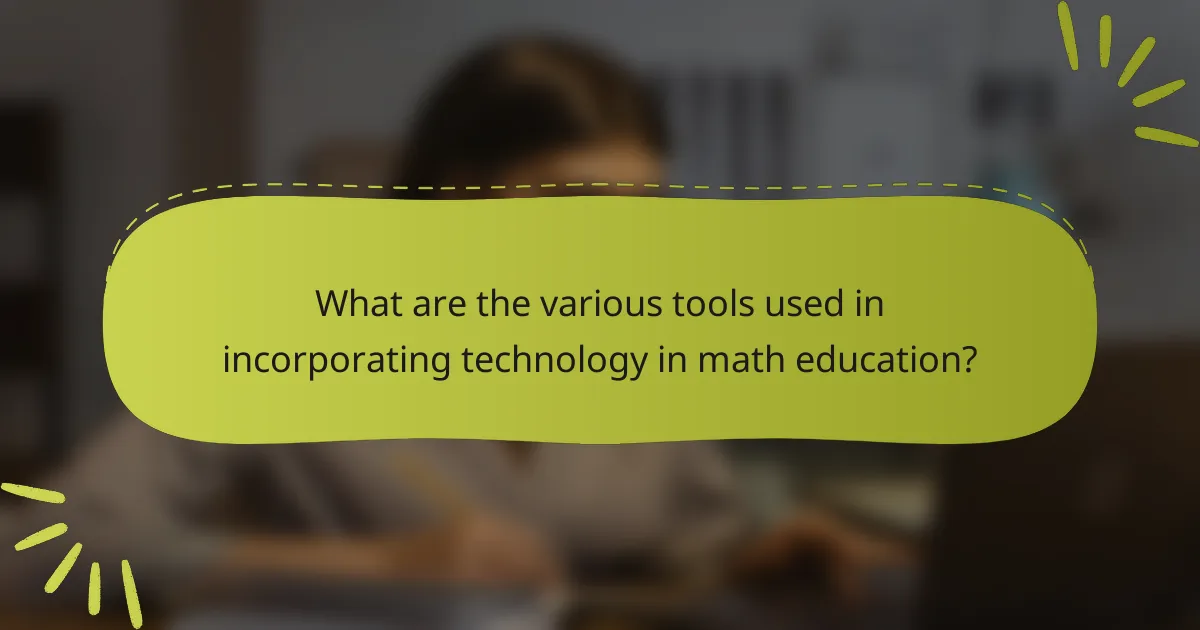
What are the various tools used in incorporating technology in math education?
Various tools used in incorporating technology in math education include interactive software, online platforms, and digital resources. Interactive software like GeoGebra allows students to visualize mathematical concepts. Online platforms such as Khan Academy provide instructional videos and practice exercises. Digital resources include graphing calculators and math apps for problem-solving. Classroom response systems enable real-time feedback during lessons. Learning management systems facilitate assignment distribution and tracking. Virtual manipulatives offer hands-on experiences in a digital format. These tools enhance engagement and improve understanding of mathematical concepts.
What types of software and applications are available for math education?
Types of software and applications available for math education include interactive learning platforms, assessment tools, and virtual manipulatives. Interactive learning platforms like Khan Academy and IXL provide personalized lessons and practice problems. Assessment tools such as Quizizz and Google Forms allow teachers to create quizzes and track student progress. Virtual manipulatives like GeoGebra and Desmos help students visualize mathematical concepts. These tools enhance engagement and understanding in math education. Research shows that technology integration improves student outcomes in mathematics.
How do interactive math tools improve problem-solving skills?
Interactive math tools enhance problem-solving skills by providing engaging, hands-on experiences. They allow students to visualize complex concepts through simulations and interactive graphics. This visualization aids in understanding and retention of mathematical principles. Furthermore, these tools often incorporate immediate feedback mechanisms. This feedback helps students identify errors and correct their thinking in real-time. Research indicates that students using interactive tools show improved performance in problem-solving tasks. A study by the National Mathematics Advisory Panel found that technology integration leads to deeper conceptual understanding. Consequently, students develop critical thinking and analytical skills essential for effective problem-solving.
What role do online platforms play in collaborative math learning?
Online platforms facilitate collaborative math learning by providing interactive tools and resources. These platforms enable students to work together in real-time on mathematical problems. Features such as discussion boards and shared workspaces enhance communication and idea exchange. Research shows that collaborative learning improves problem-solving skills and conceptual understanding. A study by Johnson et al. (2014) found that students using online platforms for group work performed better in math assessments. Additionally, online platforms offer diverse resources, such as video tutorials and practice exercises, that support collaborative learning efforts. Thus, they play a crucial role in enhancing engagement and collaboration in math education.
What hardware is essential for effective tech integration in math classrooms?
Essential hardware for effective tech integration in math classrooms includes interactive whiteboards, projectors, and computers. Interactive whiteboards allow teachers to present dynamic lessons and engage students interactively. Projectors facilitate the display of digital content, enhancing visual learning. Computers provide access to educational software and online resources, supporting individualized learning. Tablets can also be beneficial for student use, enabling hands-on practice with math applications. According to research from the International Society for Technology in Education, such tools significantly improve student engagement and understanding in math.
How do tablets and smartboards facilitate math instruction?
Tablets and smartboards facilitate math instruction by providing interactive and engaging learning experiences. They allow teachers to present complex mathematical concepts visually. This visual representation helps students understand abstract ideas more easily. Tablets enable personalized learning through educational apps tailored to individual student needs. Smartboards encourage collaborative problem-solving by allowing multiple students to interact with the content simultaneously. Research shows that using technology in classrooms can improve student engagement and retention of math concepts. A study by the U.S. Department of Education found that technology integration can lead to higher student achievement in mathematics.
What are the advantages of using calculators and graphing tools in math education?
Calculators and graphing tools enhance math education by promoting understanding and engagement. They allow students to visualize complex concepts easily. This visualization aids in grasping abstract ideas. Calculators provide immediate feedback on computations. This instant feedback supports learning through trial and error. Research shows that students using these tools perform better on assessments. A study by the National Council of Teachers of Mathematics found that technology integration improves problem-solving skills. Moreover, these tools save time, enabling focus on higher-order thinking. Overall, they foster a more interactive and effective learning environment.
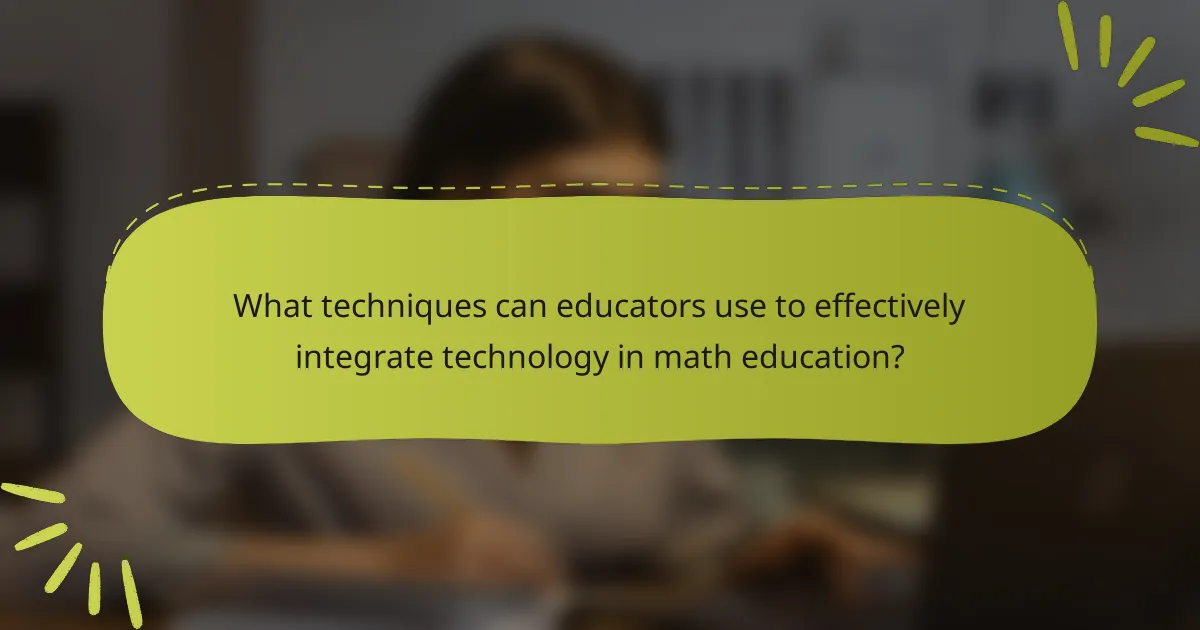
What techniques can educators use to effectively integrate technology in math education?
Educators can effectively integrate technology in math education by utilizing interactive tools, online resources, and collaborative platforms. Interactive tools like smartboards and math software engage students actively in problem-solving. Online resources, such as educational websites and apps, provide diverse practice opportunities. Collaborative platforms enable students to work together on math projects in real-time. Using data analytics tools helps educators track student progress and tailor instruction. Incorporating virtual manipulatives allows for hands-on learning experiences. Implementing flipped classrooms enables students to learn concepts at their own pace. Research shows that these techniques enhance student engagement and understanding in math.
How can teachers design lessons that incorporate technology?
Teachers can design lessons that incorporate technology by integrating digital tools and resources into their curriculum. They can use interactive software to facilitate learning and engagement. Online platforms can host collaborative projects and discussions. Teachers should also utilize educational apps that reinforce math concepts. Incorporating multimedia presentations enhances understanding of complex topics. Additionally, using data analytics tools allows for personalized learning experiences. Research shows that technology integration improves student outcomes and motivation. A study by the International Society for Technology in Education found that effective tech use leads to higher academic performance.
What strategies can enhance student interaction with tech tools in math?
Interactive tools enhance student interaction with tech tools in math. Strategies include using gamification to make learning engaging. Incorporating real-world applications helps students see relevance. Providing collaborative platforms fosters teamwork and communication. Offering personalized learning paths addresses individual student needs. Utilizing multimedia resources caters to various learning styles. Regular feedback through assessments keeps students informed on their progress. Training teachers on tech integration supports effective implementation.
How do project-based learning and technology work together in math education?
Project-based learning and technology integrate effectively in math education by enhancing student engagement and facilitating real-world problem-solving. Project-based learning encourages students to explore mathematical concepts through hands-on projects. This method promotes critical thinking and collaboration among students. Technology supports this approach by providing tools such as simulations, interactive software, and online resources. These tools allow students to visualize complex mathematical ideas and manipulate variables in real-time. For instance, platforms like GeoGebra enable dynamic geometry exploration. Research shows that students using technology in project-based learning demonstrate improved understanding and retention of mathematical concepts. A study by Hwang et al. (2019) highlights that technology-rich project-based learning environments lead to higher student motivation and achievement in math.
What are the best practices for assessing technology’s impact on student outcomes?
Best practices for assessing technology’s impact on student outcomes include establishing clear objectives and metrics for evaluation. Educators should define what success looks like in terms of student performance and engagement. Regular data collection is essential to monitor progress over time. This can involve pre- and post-assessments to measure learning gains. Feedback from students can provide insights into their experiences with technology. Additionally, comparing outcomes across different groups can highlight effectiveness. Research shows that technology integration can enhance learning when aligned with instructional goals. A study by Hattie (2012) indicates that technology can have a significant positive effect on learning when used appropriately.
How can educators measure the effectiveness of tech tools in math learning?
Educators can measure the effectiveness of tech tools in math learning through various assessment methods. These methods include standardized tests, formative assessments, and student feedback. Standardized tests provide quantifiable data on students’ math proficiency before and after using tech tools. Formative assessments, such as quizzes and class activities, offer insights into student understanding and engagement. Student feedback can reveal perceptions of the tech tools’ usability and impact on learning. Research shows that integrating technology can improve student outcomes. A study by the U.S. Department of Education found that technology-enhanced instruction led to a 12% increase in student performance in math.
What feedback mechanisms can be established to improve tech integration?
Surveys and questionnaires can be established to gather feedback on tech integration. These tools allow educators and students to express their experiences and challenges. Regularly scheduled focus groups can facilitate in-depth discussions about technology use. These sessions promote open dialogue and collective problem-solving. Classroom observations can provide direct insights into tech effectiveness. Observers can note engagement levels and instructional strategies. Additionally, digital analytics can track usage patterns and outcomes. Data from learning management systems can highlight areas for improvement. Implementing these feedback mechanisms can lead to informed adjustments in tech integration strategies.
What practical tips can educators follow for successful technology integration in math education?
Educators can follow several practical tips for successful technology integration in math education. First, they should select appropriate tools that align with learning objectives. For instance, using graphing software can enhance students’ understanding of functions. Second, educators should provide professional development for themselves and their peers. Research shows that training increases confidence in using technology effectively. Third, integrating technology into lessons should be gradual. Starting with simple tools can help students adapt without feeling overwhelmed. Fourth, educators should encourage collaboration among students through technology. Tools like online discussion boards foster teamwork and communication skills. Fifth, regular assessment of technology’s impact on learning is crucial. Data from assessments can guide future technology use. Finally, educators should seek feedback from students on technology use. This feedback can inform adjustments and improvements.
The primary entity of this article is the integration of technology in math education. The article outlines the significant role technology plays in enhancing student engagement and understanding of mathematical concepts through various tools and techniques. It discusses key technological resources such as interactive software, online platforms, and digital tools that facilitate personalized learning and collaborative experiences. Furthermore, the article examines the impact of technology on student outcomes, highlighting research findings that demonstrate improved performance and motivation in math education. Overall, it provides a comprehensive overview of effective strategies for incorporating technology into math teaching practices.
